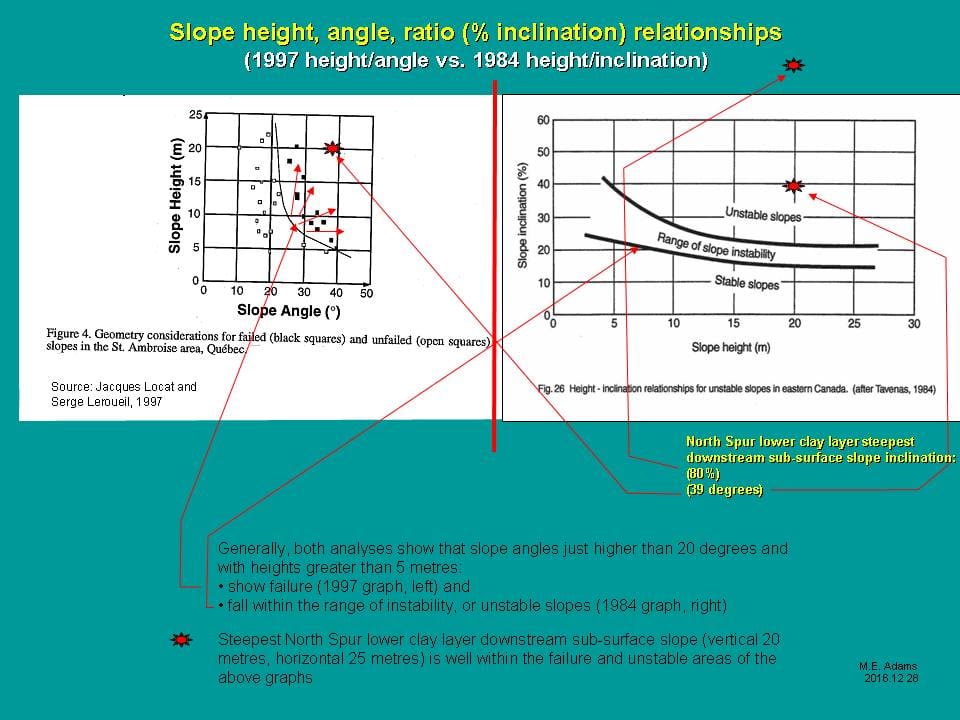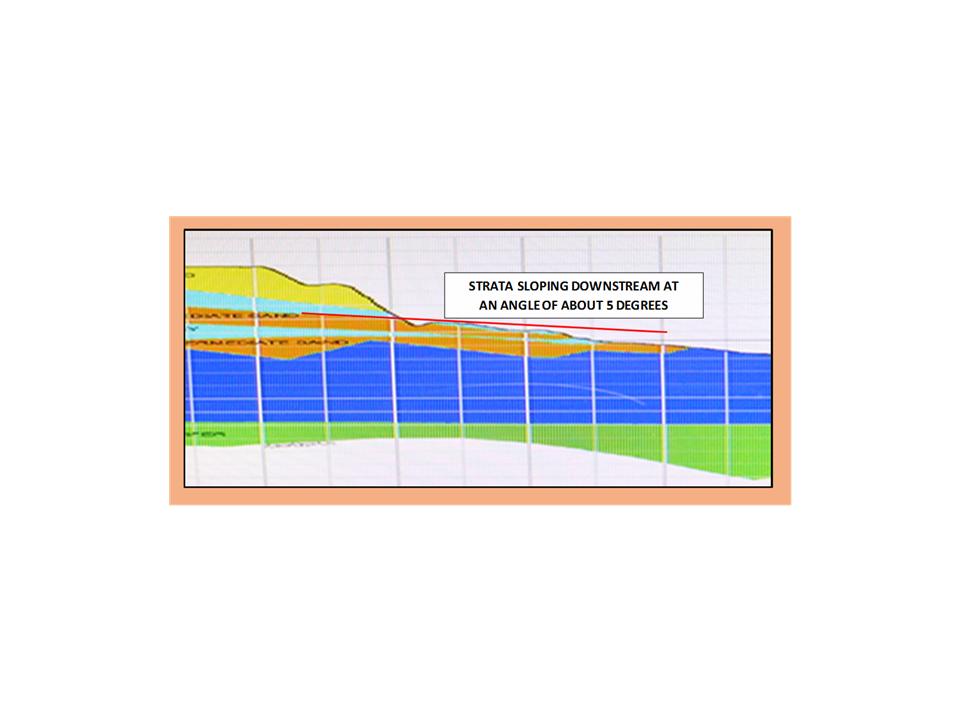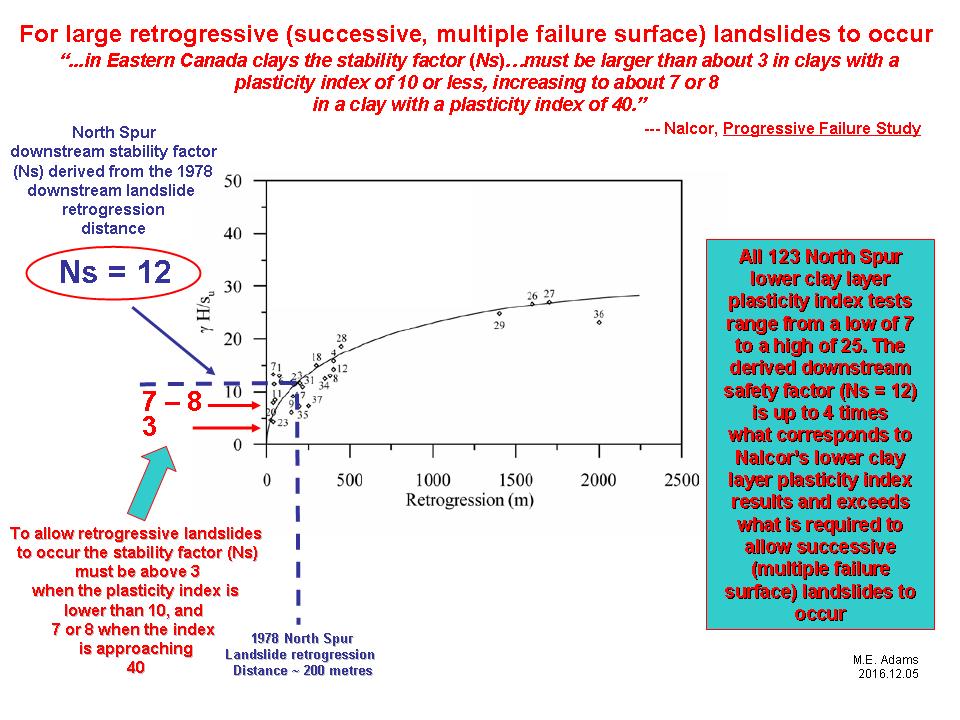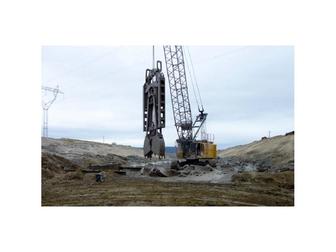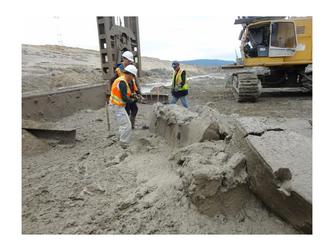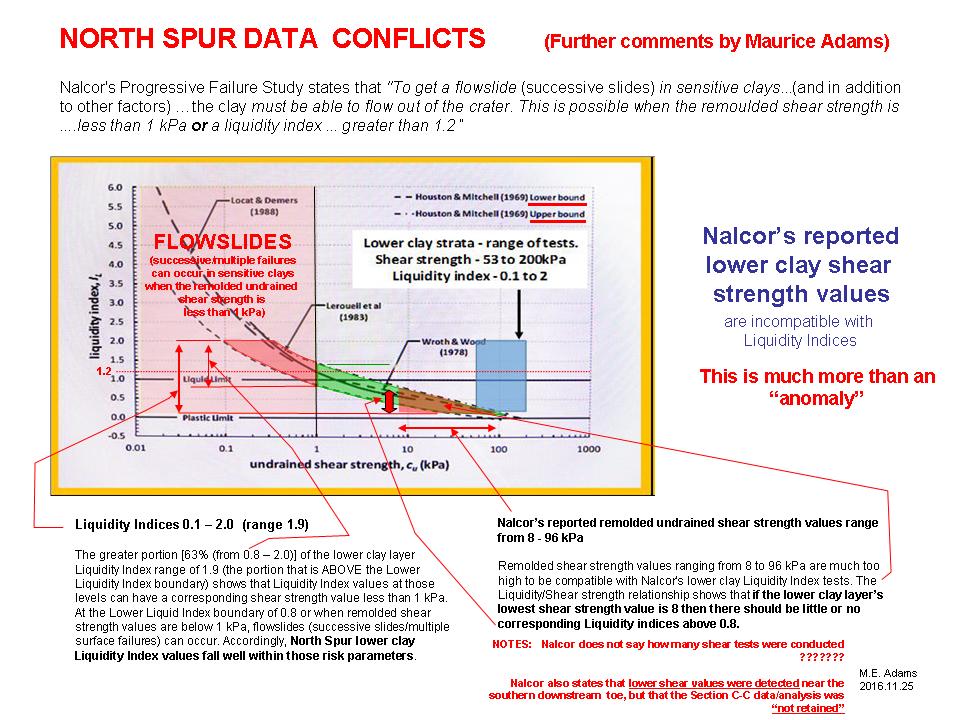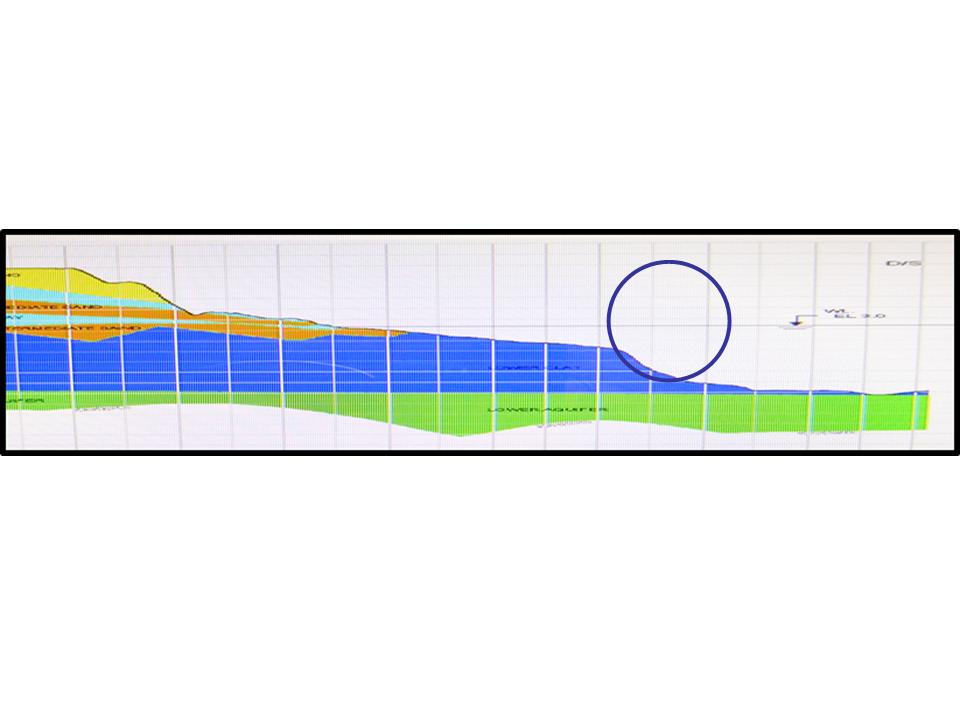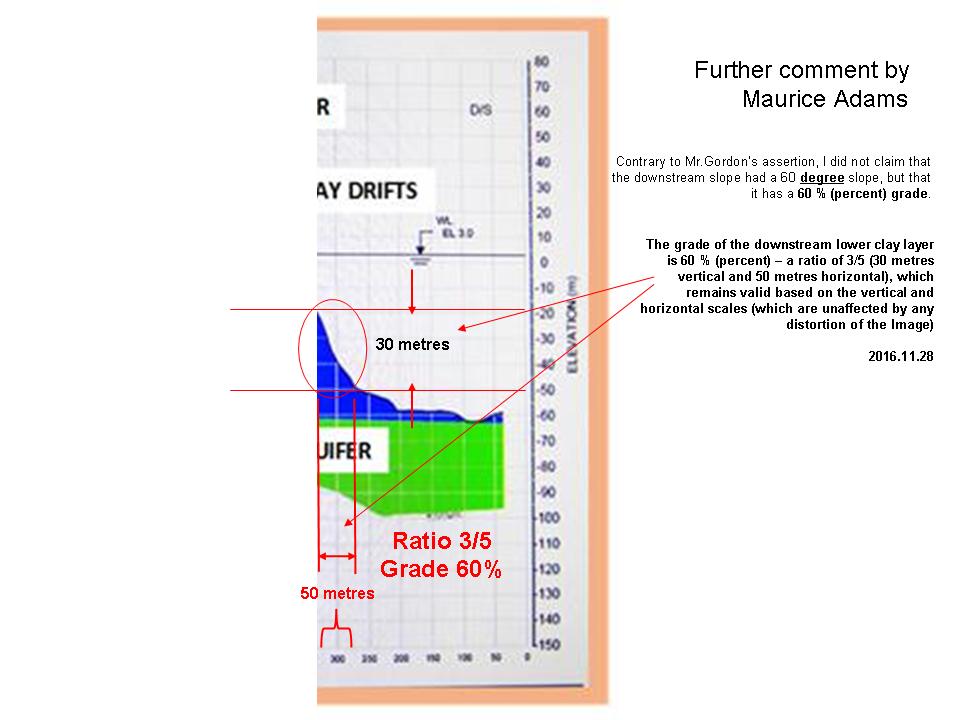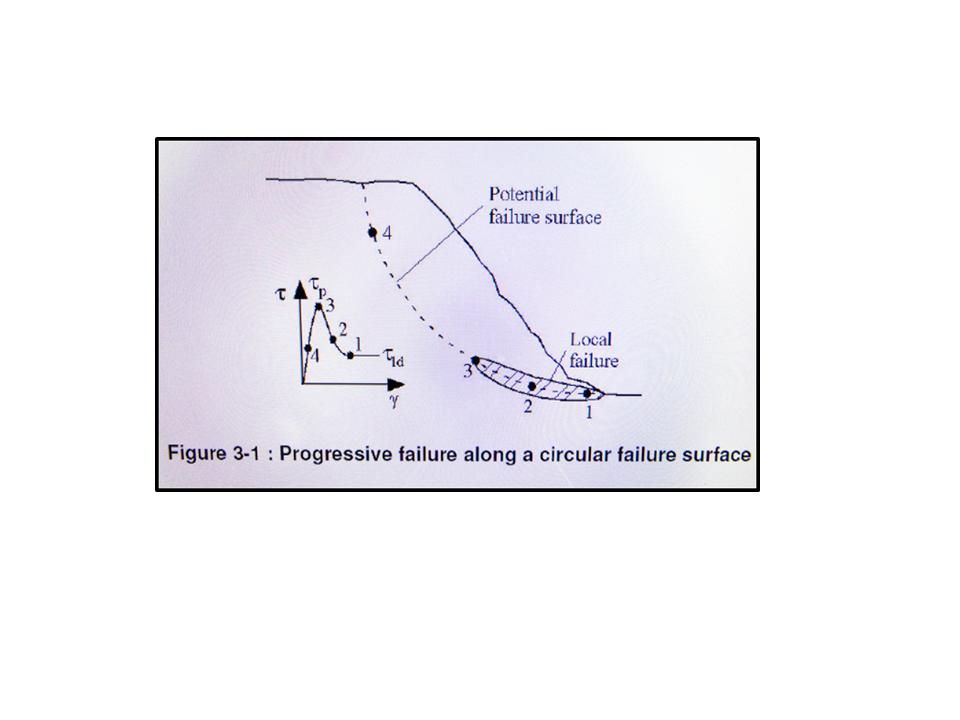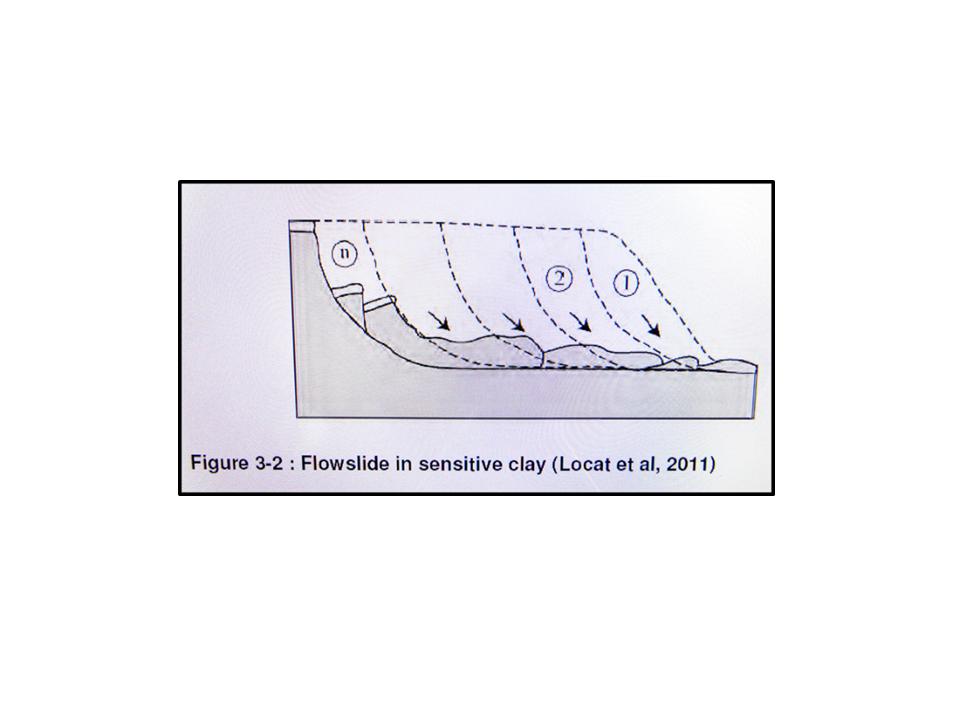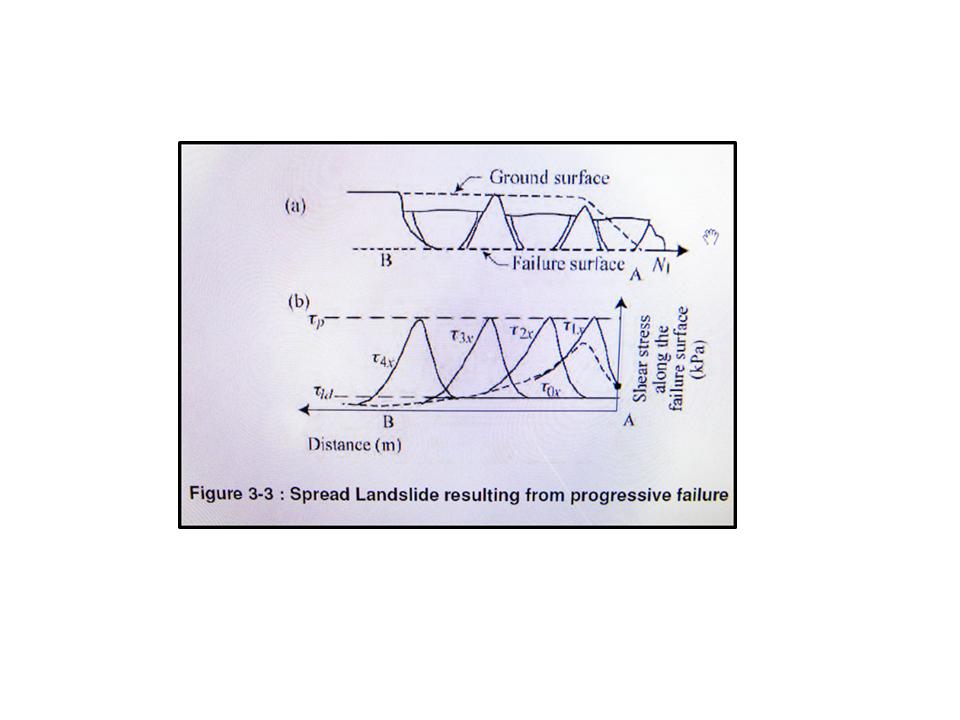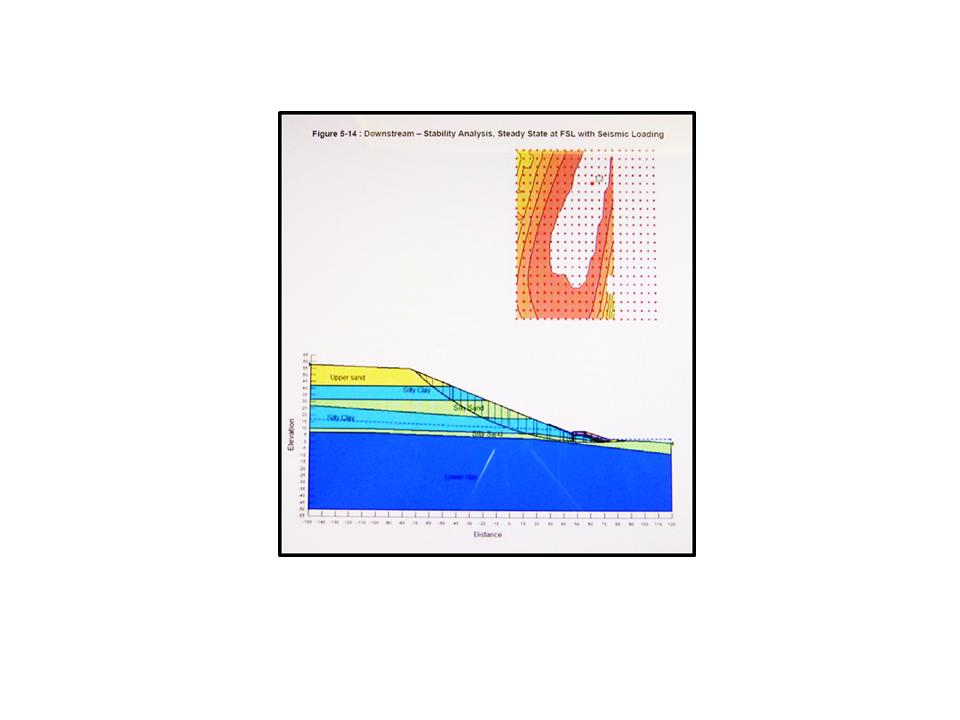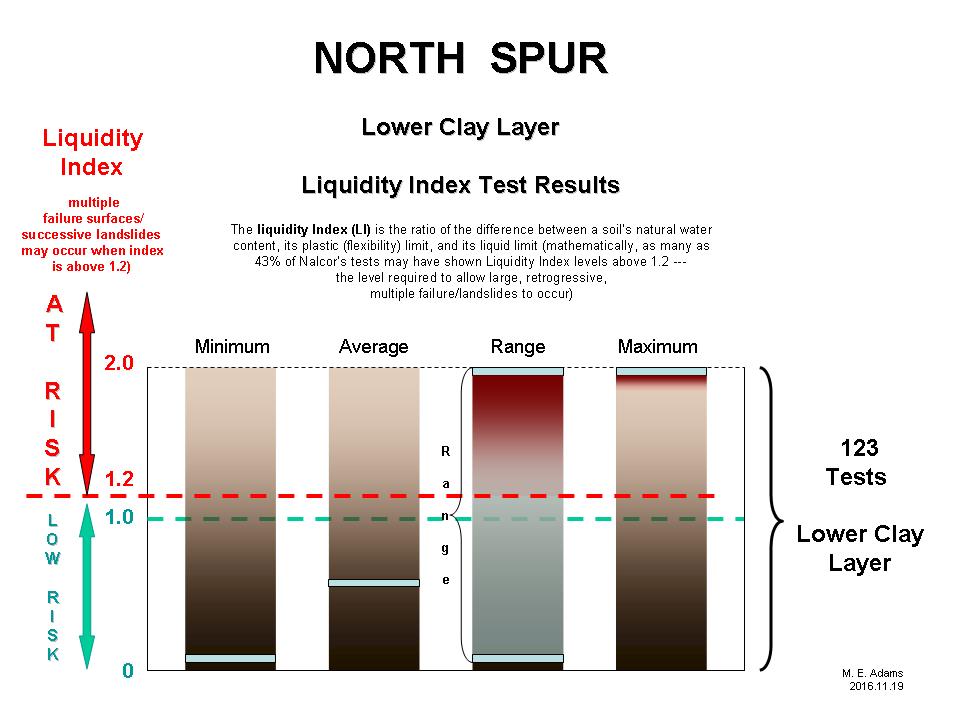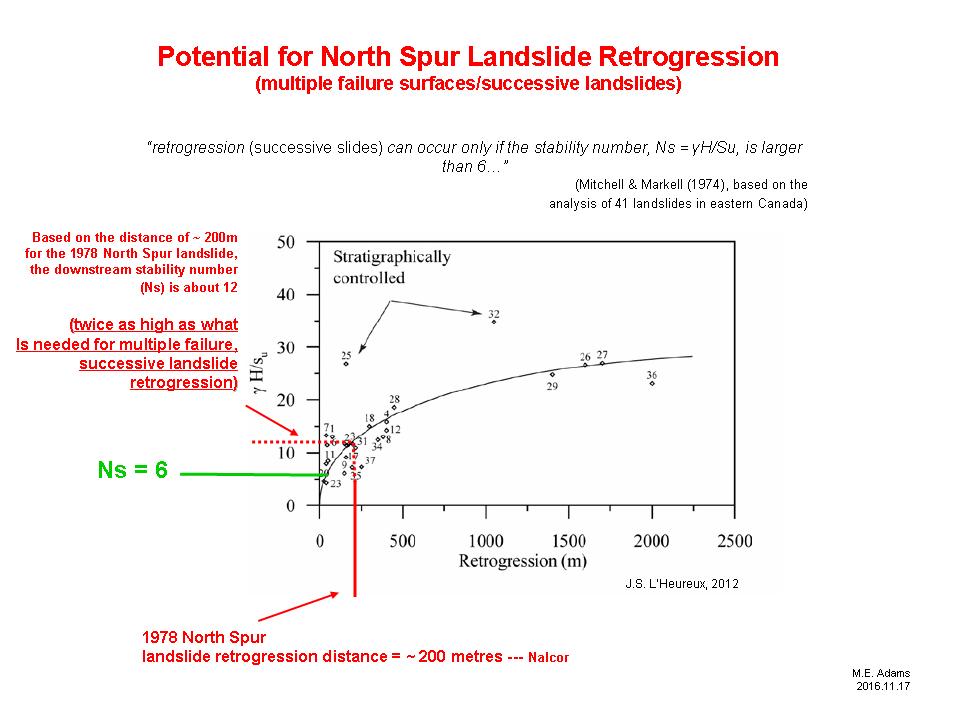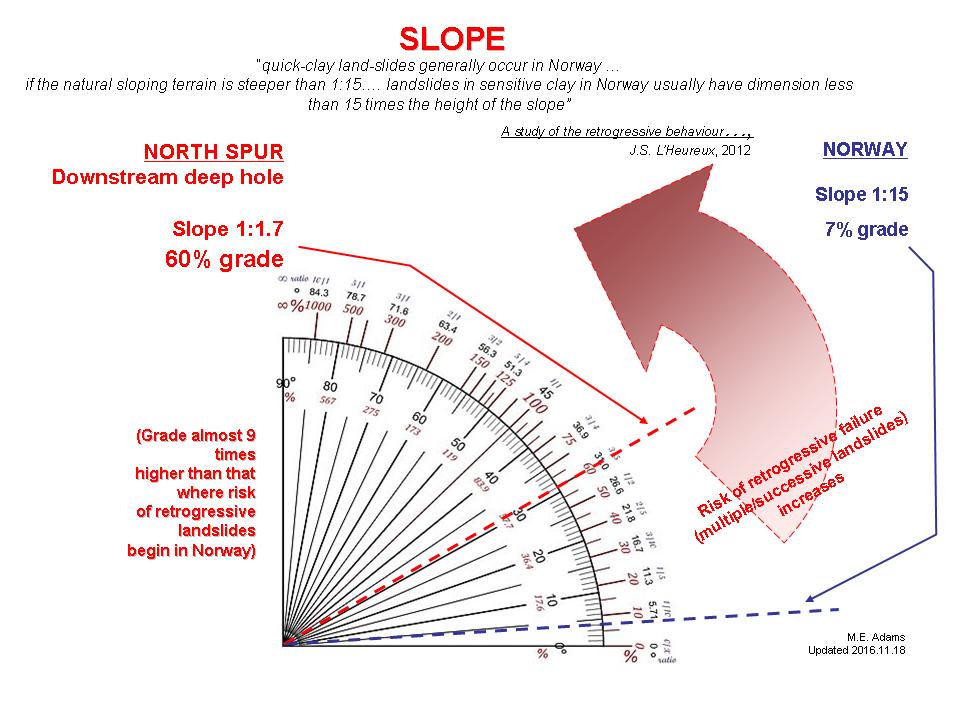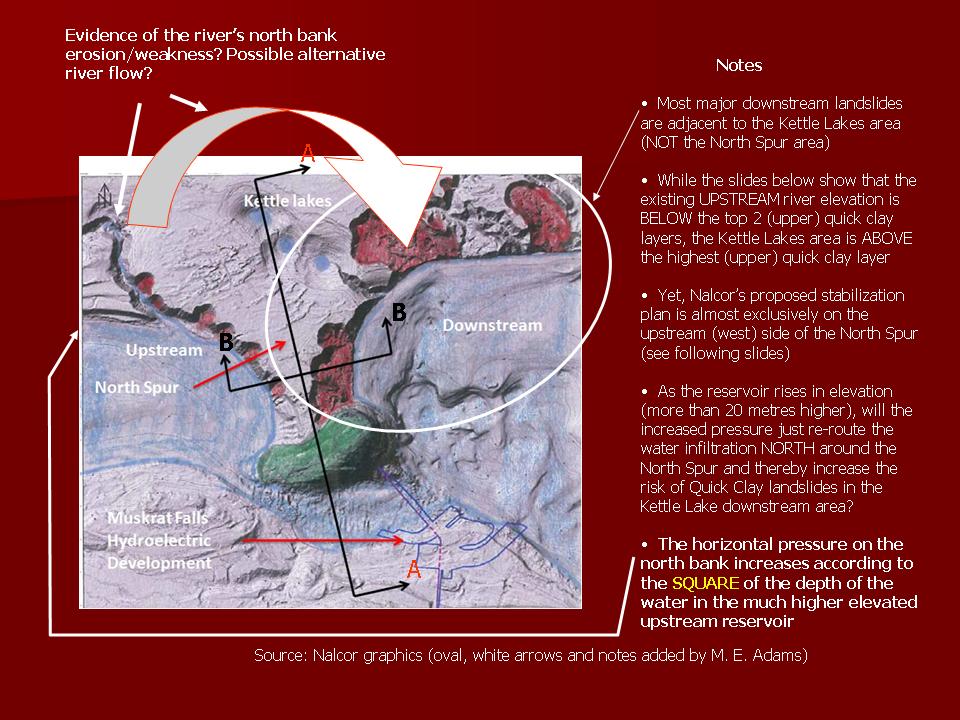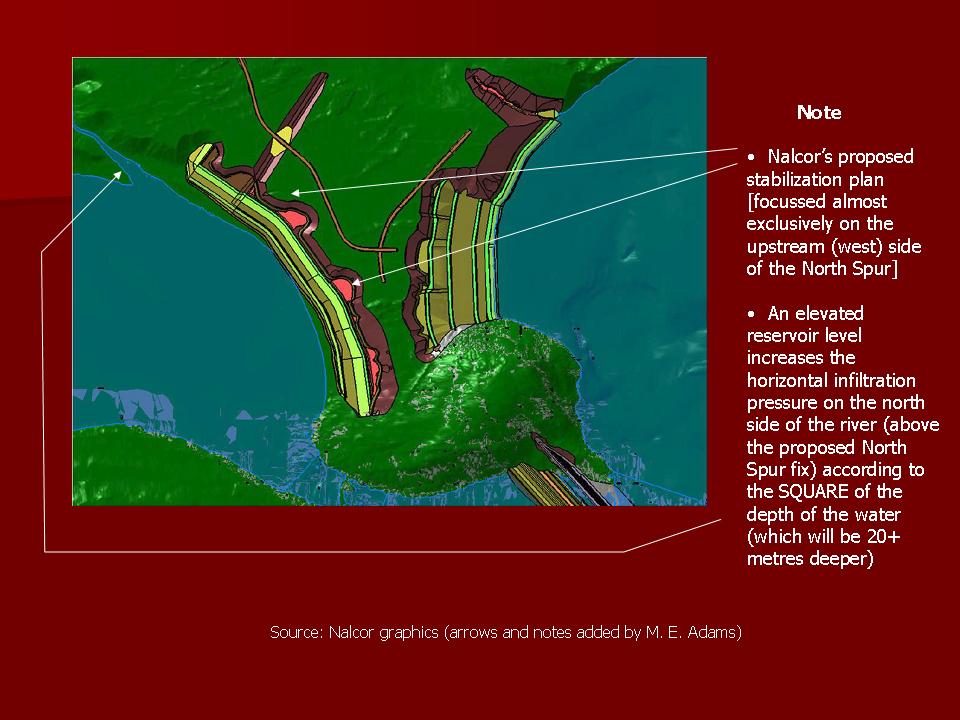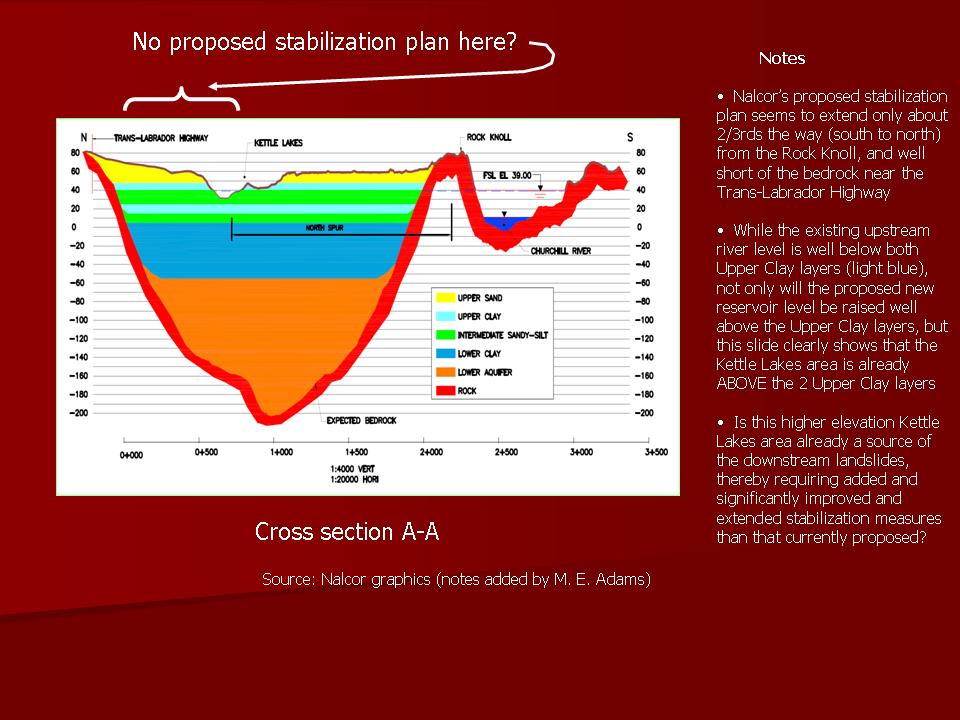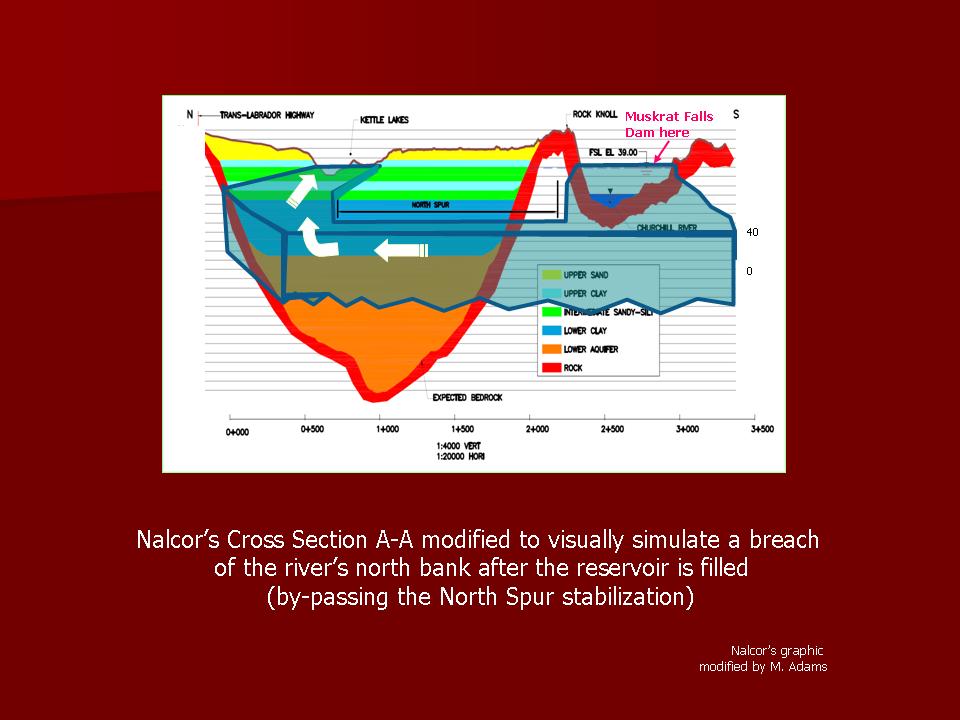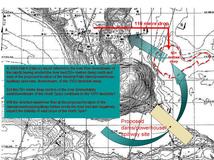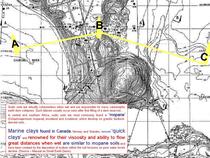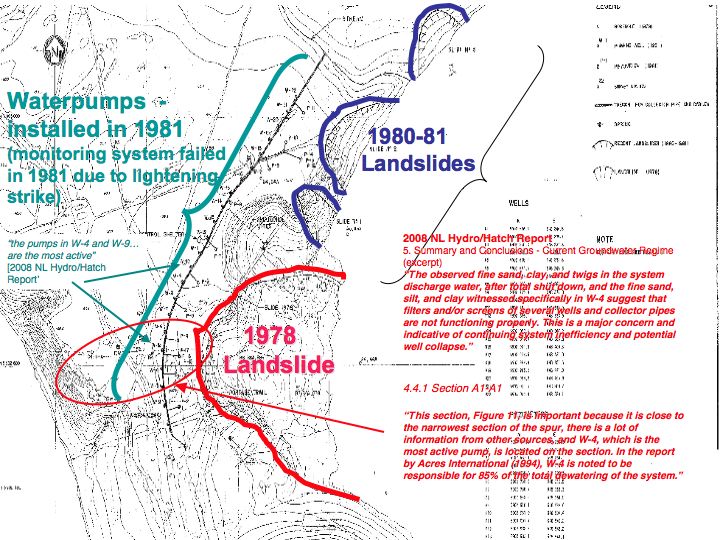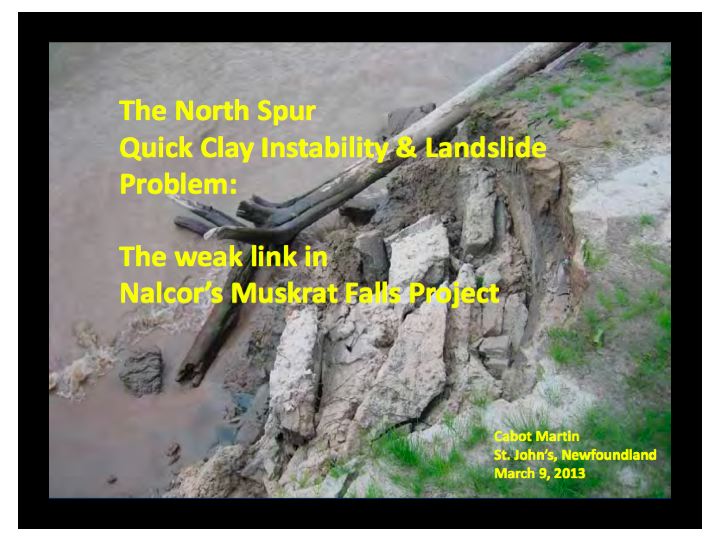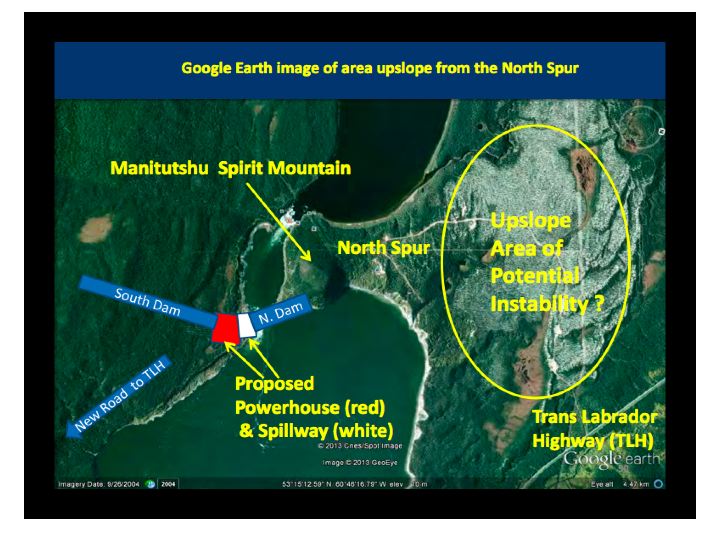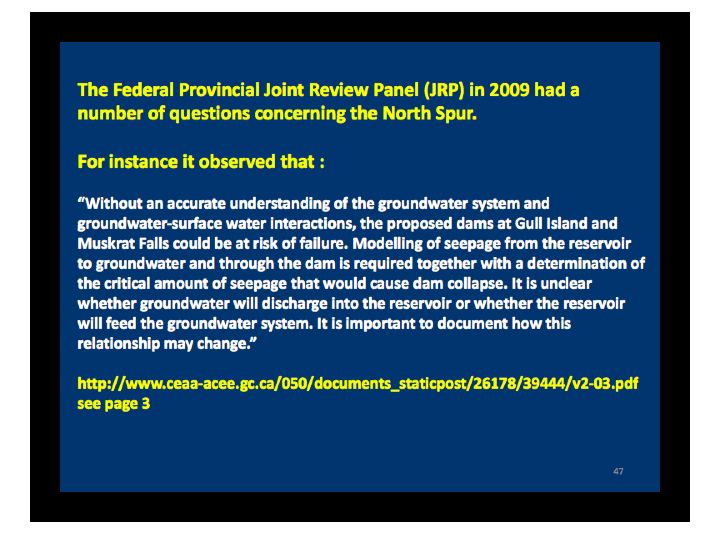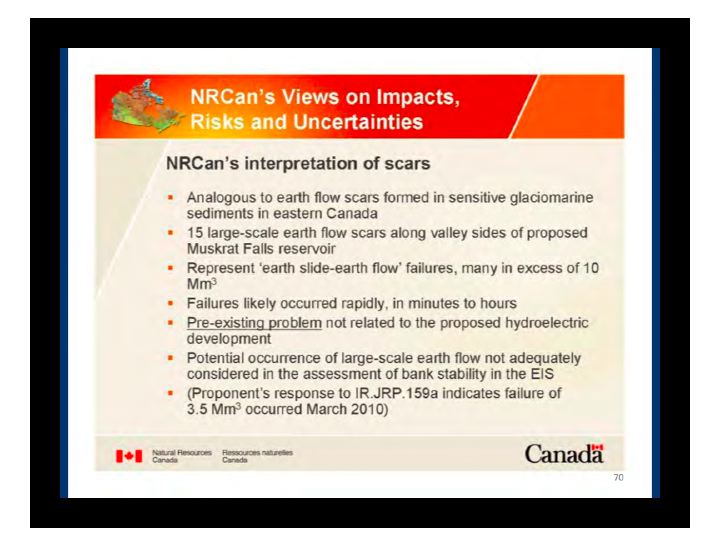17 October 2017

22 - 28 December 2016
The North Spur downstream sub-surface slope (80% incline) is twice the 40% upper range for slope stability, and at a height
of 20 metres is 4 times the safe
(5 metre) height
Combined with other high risk indicators like the lower clay layer's Liquidity Index (IL) and the downstream Stability Factor (Ns), among others, where is the evidence
that this area does not pose a significant threat to the occurrence of a
rotational slide becoming the "initial instability leading to
flow slides"
(successive, multiple failure surface landslides)?
09 December 2016
08 December 2016
- Three new factors have recently emerged that have motivated engineer Jim Gordon to again ask the question ---- "Is the North Spur Safe?"............ see Mr. Gordon's concerns (and conclusion) below:-- Maurice Adams
THE NORTH SPUR – STILL SAFE?
The answer is doubtful, likely not. Three facts have emerged since I arrived at the conclusion that the North Spur was indeed safe, which have caused me to again reverse my opinion. Two of the new facts have been published recently, and one was overlooked. One is in the recently released report for July 2016 prepared by the Independent Engineer MWH, one was found on a photograph of the upstream slope of the North Spur taken in July 2015, and the last was discovered by Mr. Maurice Adams, which will be discussed first.
Forward – When I circulated this article, I received a lengthy reply from a person with a non-scientific degree, commenting that the article was far too difficult to be understood by a layman, and should be re-written. Unfortunately the subject matter is just too technical and consequently incomprehensible for a layman, difficult to be understood by an engineer, barely understandable by a geotechnical engineer, and clearly understandable by a geotechnical engineer with a post-graduate degree in soft soils. So for the layman reader, just skip everything and read the conclusion only.
1. The Liquidity Index
This index measures the moisture content in the soil which is related to strength. The definition can be found on Wikipedia as –
The liquid limit (LL) is conceptually defined as the water content at which the behavior of a clayey soil changes from plastic to liquid. However, the transition from plastic to liquid behavior is gradual over a range of water contents, and the shear strength of the soil is not actually zero at the liquid limit.
There is a relationship between the liquid limit and shear strength, with higher liquid limits defining lower shear strength soil. The shear strength is a required input to the FLAC program used to determine dam slope stability. The liquid limit is not required, and this is the reason I did not see the inconsistency in the NALCOR tests, which indicated both a high shear strength and a high liquid limit. In the 2016 NALCOR report on the North Spur slope stability, there is a statement on page 98 that –
Liquidity index values vary between 0.1 and 2.0 with an average value of 0.6.
The consistency of the clay can be qualified as stiff to very stiff, measured with in-situ undrained shear strength values varying between 53 and 200kPa.
There is a major inconsistency in these results, since with a liquidity index ranging between 0.1 and 2.0, the shear strength values should be within the range of about 0.1 and 100kPa based on the extreme upper and lower bounds as determined by Houston and Mitchell shown in Figure 1.
Note that the liquidity index to shear strength relationship has been determined by several scientists, including Dr. Locat and Dr. Lerouell, both from Laval University in Quebec City. Dr. Lerouell has reviewed the North Spur dam design, but did not comment on the liquidity index tests.
Figure 1 – Relationship between the liquidity index and shear strength.
Source - The undrained strength – liquidity index relationship. Dr. P. J. Vardanega, Dr. S. K. Haigh. Canadian Geotechnical Journal, 04/28/2014. Page 32, reproduced in Figure 1, with the Muskrat data added.
The reasons for this inconsistency have to be investigated further. The inconsistency may indicate that there is an error of about one magnitude (10) in either one or the other.
2. The upstream slope
The second new fact is a photograph, reproduced in Figure 2, of the temporary 2.0:1 (a slope of 2m horizontal and a 1m drop vertically) slope in the upstream face excavated into the North Spur, taken in July 2015. I found it when looking for cofferdam photo at -
http://www.cbc.ca/news/canada/newfoundland-labrador/muskrat-fall-s-north-spur-stabilization-work-underway-1.3173784
The sloping arrows in Figure 2 indicate where landslides or “slips” have occurred, with the debris encroaching on the foundation area for the clay seal. Where the slips happened, the slope safety factor must be just below 1.0, and where the slope is stable, the safety factor must be just above 1.0. Overall, the safety factor can be taken as 1.0. The safety factor is the ratio of failure stress to working stress. For example, the safety factor of an elevator rope is over 5, meaning that it would take more than 5 times the passenger load to break the rope.
Source - The undrained strength – liquidity index relationship. Dr. P. J. Vardanega, Dr. S. K. Haigh. Canadian Geotechnical Journal, 04/28/2014. Page 32, reproduced in Figure 1, with the Muskrat data added.
The reasons for this inconsistency have to be investigated further. The inconsistency may indicate that there is an error of about one magnitude (10) in either one or the other.
2. The upstream slope
The second new fact is a photograph, reproduced in Figure 2, of the temporary 2.0:1 (a slope of 2m horizontal and a 1m drop vertically) slope in the upstream face excavated into the North Spur, taken in July 2015. I found it when looking for cofferdam photo at -
http://www.cbc.ca/news/canada/newfoundland-labrador/muskrat-fall-s-north-spur-stabilization-work-underway-1.3173784
The sloping arrows in Figure 2 indicate where landslides or “slips” have occurred, with the debris encroaching on the foundation area for the clay seal. Where the slips happened, the slope safety factor must be just below 1.0, and where the slope is stable, the safety factor must be just above 1.0. Overall, the safety factor can be taken as 1.0. The safety factor is the ratio of failure stress to working stress. For example, the safety factor of an elevator rope is over 5, meaning that it would take more than 5 times the passenger load to break the rope.
Figure 2. Photo of upstream slope on North Spur, July 2015.
Figure 3. Section through upstream slope with typical failure surface added.
Source - NALCOR 2016 report, page 149. Please excuse the lack of clarity. All NALCOR published drawings are out of focus and illegible even when enlarged.
In the CDA guidelines, there is no suggested safety factor for temporary slopes, since during construction of a dam, there are no temporary slopes. However, it must be acknowledged that a safety factor of 1.0 is not acceptable. A safety factor of 1.3 would be more appropriate, since this is the CDA suggested safety factor during an earthquake, another temporary state.
The upstream slope has now been covered with layers of clay and gravel sloping at 3:1 and slightly steeper at 2.5:1 towards the bottom. It is not known whether this is adequate. One observation is that embankment dams are never built with a lower slope steeper than an upper slope, since this would decrease the factor of safety.
With a demonstrated safety factor of 1.0 at a slope of 2.0:1, this information should now be used to back-analyse and determine the corresponding shear strength, to be used in determining the slope with a safety factor of 1.5 as required by the CDA guidelines. It is expected that this slope will be flatter than 3:1 upstream and 2.5:1 downstream.
3. The quick clay
The third new fact is the discovery of two pockets of quick clay in the North Spur. This is a game-changer. They were discovered sometime in November of last year. The first public knowledge of the discovery was mentioned in the recently released report by the Independent Engineer for mid-July 2016. To quote –
A unique occurrence of “very sensitive” or “quick clay” occurred at an area of the downstream slope during excavations in late 2015. Nalcor reported in November 2015 quick clay at excavations in a localized area. This material liquefied when being placed in the dumps of the trucks and flowed back out of the trucks as they proceeded upgrade. Nalcor/SNC geotechnical staff informed the IE in January, 2016 that material is local and, so far, is limited to two pockets of material. They reported that only single layers have been identified and the strata is not continuous along the downstream area. It was stated that layers were identified at elevations varying between 27 m and 25 to 22 m in the area of station 0+350 and at elevations varying between 33 m and 30 to 28 m in the area of station 0+410. According to site staff, high sensitive clays had been expected and included in slope designs but the amount encountered to date is far less than expected.
It is a pity that this information was not forwarded to senior management, since Mr. Gilbert Bennett, Executive Vice-President Power Development, on September 16th 2016, mentioned three times during his inspection of the Muskrat site accompanied by some residents from Goose Bay and Happy Valley, that “there is no quick clay in the North Spur”.
The quick clay location is critical, since the strata in this area are sloping downstream at an angle of about 5 degrees, as shown by the red line in Figure 4. With the quick clay at an elevation of 27m, and with the Spur crest at about El. 62m, this means that there is a 35m thick slab of sand, silt and clay resting on the quick clay, all on the verge of sliding downstream under the slightest provocation. To make matters worse, the small restraint provided by material downstream of the quick clay deposit has now been removed, resulting in a decrease in stability.The situation needs to be monitored daily, looking for cracks on the surface above the quick clay.
Source - NALCOR 2016 report, page 149. Please excuse the lack of clarity. All NALCOR published drawings are out of focus and illegible even when enlarged.
In the CDA guidelines, there is no suggested safety factor for temporary slopes, since during construction of a dam, there are no temporary slopes. However, it must be acknowledged that a safety factor of 1.0 is not acceptable. A safety factor of 1.3 would be more appropriate, since this is the CDA suggested safety factor during an earthquake, another temporary state.
The upstream slope has now been covered with layers of clay and gravel sloping at 3:1 and slightly steeper at 2.5:1 towards the bottom. It is not known whether this is adequate. One observation is that embankment dams are never built with a lower slope steeper than an upper slope, since this would decrease the factor of safety.
With a demonstrated safety factor of 1.0 at a slope of 2.0:1, this information should now be used to back-analyse and determine the corresponding shear strength, to be used in determining the slope with a safety factor of 1.5 as required by the CDA guidelines. It is expected that this slope will be flatter than 3:1 upstream and 2.5:1 downstream.
3. The quick clay
The third new fact is the discovery of two pockets of quick clay in the North Spur. This is a game-changer. They were discovered sometime in November of last year. The first public knowledge of the discovery was mentioned in the recently released report by the Independent Engineer for mid-July 2016. To quote –
A unique occurrence of “very sensitive” or “quick clay” occurred at an area of the downstream slope during excavations in late 2015. Nalcor reported in November 2015 quick clay at excavations in a localized area. This material liquefied when being placed in the dumps of the trucks and flowed back out of the trucks as they proceeded upgrade. Nalcor/SNC geotechnical staff informed the IE in January, 2016 that material is local and, so far, is limited to two pockets of material. They reported that only single layers have been identified and the strata is not continuous along the downstream area. It was stated that layers were identified at elevations varying between 27 m and 25 to 22 m in the area of station 0+350 and at elevations varying between 33 m and 30 to 28 m in the area of station 0+410. According to site staff, high sensitive clays had been expected and included in slope designs but the amount encountered to date is far less than expected.
It is a pity that this information was not forwarded to senior management, since Mr. Gilbert Bennett, Executive Vice-President Power Development, on September 16th 2016, mentioned three times during his inspection of the Muskrat site accompanied by some residents from Goose Bay and Happy Valley, that “there is no quick clay in the North Spur”.
The quick clay location is critical, since the strata in this area are sloping downstream at an angle of about 5 degrees, as shown by the red line in Figure 4. With the quick clay at an elevation of 27m, and with the Spur crest at about El. 62m, this means that there is a 35m thick slab of sand, silt and clay resting on the quick clay, all on the verge of sliding downstream under the slightest provocation. To make matters worse, the small restraint provided by material downstream of the quick clay deposit has now been removed, resulting in a decrease in stability.The situation needs to be monitored daily, looking for cracks on the surface above the quick clay.
Figure 4. Sloping strata in the North Spur.
Source – North Spur Updated, report by the Independent Engineer dated 21 July 2014. Page 13, with vertical distortion removed.
The extent of the quick clay deposits is not known, and with two now identified, it is likely that there are several more. It is now apparent that a more detailed geotechnical investigation is required to search for other deposits. The presence of some quick clay was included in the dam design, but how this was achieved using the FLAC program for dam safety analysis is not provided. The North Spur dam design certainly needs to be reviewed based on the presence of the quick clay, after further investigations to determine the extent of the deposit.
Winter has now arrived at the Muskrat site. This makes searching for cracks in the surface above the quick clay easier, since the crack will be clearly visible, as shown on Figure 5.
Source – North Spur Updated, report by the Independent Engineer dated 21 July 2014. Page 13, with vertical distortion removed.
The extent of the quick clay deposits is not known, and with two now identified, it is likely that there are several more. It is now apparent that a more detailed geotechnical investigation is required to search for other deposits. The presence of some quick clay was included in the dam design, but how this was achieved using the FLAC program for dam safety analysis is not provided. The North Spur dam design certainly needs to be reviewed based on the presence of the quick clay, after further investigations to determine the extent of the deposit.
Winter has now arrived at the Muskrat site. This makes searching for cracks in the surface above the quick clay easier, since the crack will be clearly visible, as shown on Figure 5.
Figure 5. Personal photo of 2m thick slab of clay sliding off the downstream face of a dam.
In the above case, the slab was sliding down at a rate of 0.3m per hour, on another clay layer. Unfortunately, this will not be the case at Muskrat, where on liquefaction of the clay layer, the movement of the overlying material will be swift, raising the question of safety for any worker in the area below the quick clay exposures. This rapid progression of landslides in the vicinity of Muskrat Falls is mentioned in a letter to NALCOR dated December 18th, 2009.
This style of failure is typical of a complex, retrogressive, rapid to very rapid (m/min to m/sec) earth slide.
Source – Lower Churchill Generation Project – Natural Resources Canada. Response to additional information provided by NALCOR Energy, page 5.
__________________________________________________________________________________________________________________________________
Conclusions – This new data indicates that it is now absolutely essential to have an independent Review Board undertake a comprehensive assessment of the stability of the North Spur.
There have been some suggestions that the mandate of the Review Board should be extended to cover the entire project. This would be a mistake, since the expertise of the Review Board members will be mainly geotechnical and not general.
Jim Gordon, Peng. (Retired)
__________________________________________________________________________________________________________________________________
In the above case, the slab was sliding down at a rate of 0.3m per hour, on another clay layer. Unfortunately, this will not be the case at Muskrat, where on liquefaction of the clay layer, the movement of the overlying material will be swift, raising the question of safety for any worker in the area below the quick clay exposures. This rapid progression of landslides in the vicinity of Muskrat Falls is mentioned in a letter to NALCOR dated December 18th, 2009.
This style of failure is typical of a complex, retrogressive, rapid to very rapid (m/min to m/sec) earth slide.
Source – Lower Churchill Generation Project – Natural Resources Canada. Response to additional information provided by NALCOR Energy, page 5.
__________________________________________________________________________________________________________________________________
Conclusions – This new data indicates that it is now absolutely essential to have an independent Review Board undertake a comprehensive assessment of the stability of the North Spur.
There have been some suggestions that the mandate of the Review Board should be extended to cover the entire project. This would be a mistake, since the expertise of the Review Board members will be mainly geotechnical and not general.
Jim Gordon, Peng. (Retired)
__________________________________________________________________________________________________________________________________
05 December 2016
Plasticity Index/Stability Factor Relationship ----- See below info-graphic (and note my 03 December posting of Independent Engineer photos showing plastic lower clay layer)
03 December 2016
- Independent Engineer's Quality Assurance Report dated November 2, 2016 (cofferdam problems and NS downstream quick clay identified)
CLICK PHOTO TO ENLARGE
26 November 2016
Below are engineer Jim Gordon's "Comments on Maurice Adams critique of Gordon North Spur safety analysis."
For greater clarity, Mr. Gordon's comments have been posted in brighter white, and in the near future I plan to show in a number of respects (See my added comments in blue and added Figures "A" and "B") where Mr. Gordon is in error -- Maurice Adams.
The Adams critique text is shown in italics -
Nalcor's Progressive Failure Study states that "Flowslides in sensitive clays result from a succession of slides ... (emphasis added), and "To get a flowslide in sensitive clays...:"there must be an initial failure"..., enough potential energy for remoulding the clay, Once remoulded, the clay must be able to flow out of the crater. ["A common feature of the previous slides on the North Spur is that very little slide debris remained in the slide bowl which is an indication of the sensitive nature of the soils involved in the slide" - Nalcor]. This is possible when the remoulded shear strength is ....less than 1 kPa or a liquidity index... greater than 1.2 , (emphasis added) , (and)...there must be topography which permits the evacuation of the liquefied debris"
Nalcor reports that 123 tests of the lower clay layer shows a Liquid Index ranging from 0.1 to 2.0, with an average of 0.6. Mathematically, this means that 43% of the tests could exceed the Liquid Index needed to trigger a flowslide (successive slides), Howeveer, Nalcor uses the average liquid index of 0.6 to conclude that a flowslide will not occur.
However, the shear strength ranges between 53 and 200kPa, far stronger than the requirement for the shear strength to be less than the 1kPa required to trigger a flowslide. (Source – North Spur Stabilization Works – Design Report. Page 99. 30 January, 2016)
On the other hand, this implies an anomaly in the NALCOR test data, since the tests do not appear to follow the normal relationship between the liquidity limit and the undrained shear strength as shown on the Figure 1.(Source – The undrained strength – liquidity index relationship. Dr. P. J. Vardanega, Dr. S. K. Haigh. Canadian Geotechnical Journal, 04/28/2014. Page 32). (https://www.repository.cam.ac.uk/bitstream/handle/1810/245384/The%20undrained%20strength%20-%20liquidity%20index%20relationship.pdf?sequence=10
Figure 1 indicates that any clay with a liquidity index of 1.5 to 2.0 should have an undrained shear strength of about 0.13 to 1,0kPa, whereas the minimum tested shear strength is 53kPa.
It is therefore suspected that the high liquidity index is due to the samples being obtained from clay which has been submerged for millennia, wherein the normal relationship between shear strength and liquidity are not applicable (Mr. Gordon provides no evidence to support this claim - M.E. Adams). However, this should be determined by NALCOR.
Incidentally, the liquidity index is not an input required for calculating the dam slope safety factor in a FLAC analysis used on dams which are not subjected to a progressive spread slides. This is likely to be the reason the anomaly has not been mentioned.
(Source - http://www.itascacg.com/software/flac/videos/flac-70-slope-stability-analysis )
Figure 1 – Relationship between liquidity index and shear strength.
Presentation [Non-textbook Flowslides in Fine-grained Colluvium], Hungr, University of British Columbia, contains this statement "Liquefaction requires a special type of material: Loose, 'collapsive' sand or silt or Extra-sensitive ("quick" clay)"
Jim Gordon however, suggests that Nalcor’s 2016 report states that the lower clay sensitivity is “stiff, to very stiff” and that the North Spur is safe, in part, because the downstream landslides are “flowslides. When in fact, Nalcor states that the sensitivity values for the lower clay layer indicates "that the class of sensitivity of the clay can be classified as low to extra sensitive" (emphasis added)”.
NALCOR sensitivity tests indicate a range of 2 – 11 for the lower clay, far too low for the clay to be regarded as liquefiable. (Source- NALCOR 2016 report, page 99). Liquefiable clay has sensitivity indices higher than 30 to 50. The NALCOR interpretation of the sensitivity index appears to be incorrect.
(Source – Studies on the Properties and Formation of Quick Clays, Dr. J. Osterman, Swedish Geotechnical Institute. Page 87). http://www.clays.org/journal/archive/volume%2012/12-1-87.pdf
Another definition of quick clay is “According to the Swedish definition of quick clay, the remoulded shear strength must be equal to or less than 0.4 kPa if the clay is to be designated as quick”.Source – Swedish Geotechnical Institute, Report #65 “Quick clay in Sweden” page 39.
http://www.swedgeo.se/globalassets/publikationer/rapporter/pdf/sgi-r65.pdf
The lower marine clay unit has a remoulded shear strength ranging between 8 and 96kPa, far too high to be classified as “quick”.
Source – NALCOR 2016 Report, page 99.
Nalcor’s Fig.3.1 Rotational landslide diagram superimposed over the steep downstream sub-aerial slope.
The diagram has a vertical distortion ratio of 5:1 which makes the downstream slope appear to be almost vertical. With no distortion, the profile is as shown in Figure 2, with a slip circle added and much flatter slopes.
Presentation [Non-textbook Flowslides in Fine-grained Colluvium], Hungr, University of British Columbia, contains this statement "Liquefaction requires a special type of material: Loose, 'collapsive' sand or silt or Extra-sensitive ("quick" clay)"
Jim Gordon however, suggests that Nalcor’s 2016 report states that the lower clay sensitivity is “stiff, to very stiff” and that the North Spur is safe, in part, because the downstream landslides are “flowslides. When in fact, Nalcor states that the sensitivity values for the lower clay layer indicates "that the class of sensitivity of the clay can be classified as low to extra sensitive" (emphasis added)”.
NALCOR sensitivity tests indicate a range of 2 – 11 for the lower clay, far too low for the clay to be regarded as liquefiable. (Source- NALCOR 2016 report, page 99). Liquefiable clay has sensitivity indices higher than 30 to 50. The NALCOR interpretation of the sensitivity index appears to be incorrect.
(Source – Studies on the Properties and Formation of Quick Clays, Dr. J. Osterman, Swedish Geotechnical Institute. Page 87). http://www.clays.org/journal/archive/volume%2012/12-1-87.pdf
Another definition of quick clay is “According to the Swedish definition of quick clay, the remoulded shear strength must be equal to or less than 0.4 kPa if the clay is to be designated as quick”.Source – Swedish Geotechnical Institute, Report #65 “Quick clay in Sweden” page 39.
http://www.swedgeo.se/globalassets/publikationer/rapporter/pdf/sgi-r65.pdf
The lower marine clay unit has a remoulded shear strength ranging between 8 and 96kPa, far too high to be classified as “quick”.
Source – NALCOR 2016 Report, page 99.
Nalcor’s Fig.3.1 Rotational landslide diagram superimposed over the steep downstream sub-aerial slope.
The diagram has a vertical distortion ratio of 5:1 which makes the downstream slope appear to be almost vertical. With no distortion, the profile is as shown in Figure 2, with a slip circle added and much flatter slopes.
Figure 2. Section through downstream slope at the North Spur.
The subsequent comment by Mr. Adams that there are 60 degree slopes at the North Spur is not correct. The steepest engineered slope is 2.5:1, or at 38 degrees. The only slopes approaching an angle of 60 degrees are at the scarps left over from landslides, where the factor of safety has been calculated by both NALCOR and Bernander as being close to unity. The scarps are all being cut back to a slope of 2.5:1.
Contrary to Mr. Gordon's narrow definition of Progressive Failure, Nalcor's 2015 North Spur Stabilization Works Progressive Failure Study states:
Section 3.1 (Progressive Failure)
Section 3.1.1 (Single Rotational Landslide) --- ---”Rotational landslides can be...the initial instability leading to flow slides ... (and) "Figure 3-1 : (with the following caption) --- "Progressive Failure along a circular surface (from Locat et al, 2011)"
Also, "Figure 3-1 illustrates how the shear strength along a potential failure surface may vary from peak shear strength to large-deformation shear strength. The soil in the potential sliding mass is therefore subjected to local failure when it reaches its peak shear strength (points 1 to 3 along the potential failure surface in Fig. 3-1, prior to global failure taking place when the entire failure surface is formed (Locat et as, 2011)" .
This is an explanation of the common circular failure surface wherein the slope safety factor can be determined by a FLAC program, as shown in Figure 3-1. Multiple flow slides can then develop as shown in Figure 3-2. The confusion arises from the over the use of the word “progressive” to describe the sequence of failure events, a word which is also used to describe spread failures which cannot be analysed by FLAC, instead have to be analysed by the Bernander or Locat methodology.
The major difference between a flow slide and a spread, is the location of the failure surface. In a flow slide the failure surface is circular, as shown in Figures 3-1 and 3-2. In a spread, the failure surface is horizontal, as shown in Figure 3-3. A spread is the type of failure which cannot be analysed by FLAC. (As I understand it, FlAC analysis can only be relied on for a slide retrogressive distance at the scarp (top) up to about 70 metres, whereas flowslides at the downstream slope of the North Spur have in the past retrogressed up to 200 metres, M. E. Adams)
The subsequent comment by Mr. Adams that there are 60 degree slopes at the North Spur is not correct. The steepest engineered slope is 2.5:1, or at 38 degrees. The only slopes approaching an angle of 60 degrees are at the scarps left over from landslides, where the factor of safety has been calculated by both NALCOR and Bernander as being close to unity. The scarps are all being cut back to a slope of 2.5:1.
Contrary to Mr. Gordon's narrow definition of Progressive Failure, Nalcor's 2015 North Spur Stabilization Works Progressive Failure Study states:
Section 3.1 (Progressive Failure)
Section 3.1.1 (Single Rotational Landslide) --- ---”Rotational landslides can be...the initial instability leading to flow slides ... (and) "Figure 3-1 : (with the following caption) --- "Progressive Failure along a circular surface (from Locat et al, 2011)"
Also, "Figure 3-1 illustrates how the shear strength along a potential failure surface may vary from peak shear strength to large-deformation shear strength. The soil in the potential sliding mass is therefore subjected to local failure when it reaches its peak shear strength (points 1 to 3 along the potential failure surface in Fig. 3-1, prior to global failure taking place when the entire failure surface is formed (Locat et as, 2011)" .
This is an explanation of the common circular failure surface wherein the slope safety factor can be determined by a FLAC program, as shown in Figure 3-1. Multiple flow slides can then develop as shown in Figure 3-2. The confusion arises from the over the use of the word “progressive” to describe the sequence of failure events, a word which is also used to describe spread failures which cannot be analysed by FLAC, instead have to be analysed by the Bernander or Locat methodology.
The major difference between a flow slide and a spread, is the location of the failure surface. In a flow slide the failure surface is circular, as shown in Figures 3-1 and 3-2. In a spread, the failure surface is horizontal, as shown in Figure 3-3. A spread is the type of failure which cannot be analysed by FLAC. (As I understand it, FlAC analysis can only be relied on for a slide retrogressive distance at the scarp (top) up to about 70 metres, whereas flowslides at the downstream slope of the North Spur have in the past retrogressed up to 200 metres, M. E. Adams)
(Source – NALCOR 2015 North Spur Stabilization Works – Progressive Failure study.)
Figure 5-14 above, shows the results of a typical FLAC analysis of the slope safety factor. Each of the red dots (upper right) represents a single analysis, repeated on a pattern to find the critical slip circle, here with a safety factor of 1.3, adequate to be within the CDA guidelines for a dam subjected to seismic loads.(Source – NALCOR North Spur Stabilization Works – Design Report. 30 Jan. 2016, page 190). (This diagram is not representative of the extremely steep downstream slopes exposed to the underwater lower clay layer from elevations -20 to -50+ metres, M. E. Adams)
__________________________________________________________________________________________________________________________________
Conclusions – The misunderstandings arise from the use of the word “progressive” to describe the sequence of events in both flow slides, and spreads; and the anomaly detected between the liquidity index and the shear strength. This anomaly should be investigated by NALCOR.
__________________________________________________________________________________________________________________________________
Jim Gordon. PEng. (Retired).
__________________________________________________________________________________________________________________________________
Conclusions – The misunderstandings arise from the use of the word “progressive” to describe the sequence of events in both flow slides, and spreads; and the anomaly detected between the liquidity index and the shear strength. This anomaly should be investigated by NALCOR.
__________________________________________________________________________________________________________________________________
Jim Gordon. PEng. (Retired).
November 2016
Engineer Jim Gordon's flip-flop on stability of North Spur on shaky ground
Potential for Multiple failure/successive landslides (retrogression)
LIQUIDITY
STABILITY
SLOPE
QUICK CLAY
 Initial underwater instability can lead to multiple failure surfaces/successive landslides (flowsides)
Initial underwater instability can lead to multiple failure surfaces/successive landslides (flowsides)
Mr. Gordon disagrees with Dr. Bernander's statement that "...layers with high sensitivity...occur in the Lower Clay formation". Instead, Mr. Gordon states that "the clay is characterised as “stiff to very stiff"... (and that) NALCOR data from tests on soil samples retrieved from the lower clay layer do not indicate the presence of soft clays"
- FACT:- Nalcor's 2016 North Spur Stabilization Works Design Report actually states that the sensitivity values for the lower clay layer indicate "that the class of sensitivity of the clay can be classified as low to extra sensitive" (emphasis added)”. Furthermore, the University of British Columbia [Hungr, Non-textbook Flowslides in Fine-grained Colluvium], states that "Liquefaction requires a special type of material: Loose, 'collapsive' sand or silt or Extra-sensitive ("quick" clay)"].
- Also, Nalcor's 2016 document goes on to say that the lower clay Liquid Index ranges from 0.1 to 2.0 over 123 tests, which means mathematically, that up to 43% of the Liquid Index tests may show the lower clay layer to be above the safe Liquid Index cut off of 1.2.
- Notwithstanding this fact, Nalcor's Progressive Failure Study relies on the lower clay layer's AVERAGE liquid index of 0.6 to conclude that "no flowslide or retrogression landslide may develop ... (and that accordingly)... The landslide would... be limited to a single rotational slide of limited depth"
- While the facts show that Nalcor classifies the sensitivity of the lower clay layer as "low to extra sensitive", the UBC (Hungr) presentation defines "Extra sensitive" (clay) as "quick" clay", and up to 43% of the Liquid Index tests may be above the 1.2 level required to allow large, retrogressive, multiple failure/landslides to occur, somehow Mr. Gordon now agrees with Nalcor and now takes a revised position that does not seem to be supported by the facts.
DATA / ANALYSES --- "NOT RETAINED"
12 October 2016

Critical North Spur data "not retained"
Nalcor's 2015 North Spur Stabilization Works - Progressive Failure Study states in part that "the undrained shear strength...at a given elevation is generally similar throughout the North Spur,...(however) some lower (undrained) shear strength were measured below the slide debris at the toe (shoreline) of the southern downstream slope".
Notwithstanding that Section C-C (see Figure 1.) corresponds most closely to the "southern downstream slope", and
While the engineering definition of risk is "the product of the probability of an event occurring...and an assessment of the expected harm from the event ...(consequence in lost money/deaths)." [ http://people.stern.nyu.edu/adamodar/pdfiles/valrisk/ch1.pdf ], Section B-B was "identified as the most critical slope of the North Spur" (emphasis added) and was thus selected as the "reference case" to which the other sections were compared.
The non-retention of the Section C-C analyses and the real (catastrophic) risk associated with a potential or actual landslide at Section C-C as compared to the real risk (probability and impact) of a what would more likely be a slide of limited magnitude and impact at Section B-B, calls for an independent and transparent analyses of Section C-C.
A decision with respect to the impoundment of the reservoir must be withheld pending the results of a Section C-C analysis.
Maurice E. Adams
Paradise, NL
Nalcor's 2015 North Spur Stabilization Works - Progressive Failure Study states in part that "the undrained shear strength...at a given elevation is generally similar throughout the North Spur,...(however) some lower (undrained) shear strength were measured below the slide debris at the toe (shoreline) of the southern downstream slope".
Notwithstanding that Section C-C (see Figure 1.) corresponds most closely to the "southern downstream slope", and
- corresponds most closely to where lower shear strength has been measured below the debris at the toe,
- has the steepest downstream shoreline to riverbed slope,
- has the least resistance to a large slide due its adjacency to the downstream deep depression,
- has been most impacted by the pre-1951 large landslide,
- is the area adjacent to the narrowest section of the North Spur, and
- is where a significant landslide could result in a catastrophic breach of the North Spur,
While the engineering definition of risk is "the product of the probability of an event occurring...and an assessment of the expected harm from the event ...(consequence in lost money/deaths)." [ http://people.stern.nyu.edu/adamodar/pdfiles/valrisk/ch1.pdf ], Section B-B was "identified as the most critical slope of the North Spur" (emphasis added) and was thus selected as the "reference case" to which the other sections were compared.
The non-retention of the Section C-C analyses and the real (catastrophic) risk associated with a potential or actual landslide at Section C-C as compared to the real risk (probability and impact) of a what would more likely be a slide of limited magnitude and impact at Section B-B, calls for an independent and transparent analyses of Section C-C.
A decision with respect to the impoundment of the reservoir must be withheld pending the results of a Section C-C analysis.
Maurice E. Adams
Paradise, NL
20 October 2014
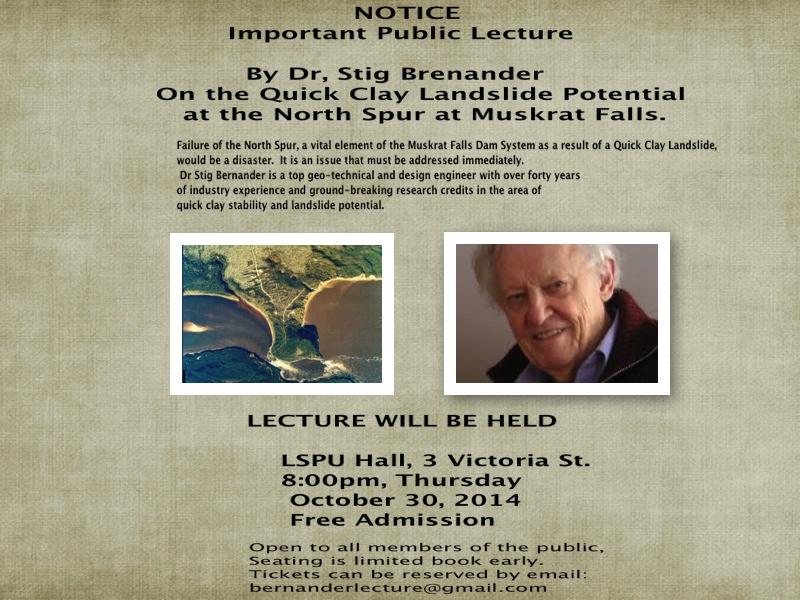
______________________________________________________________________________________________________________________________________________
NORTH SPUR
AND
ADDITIONAL
NORTH RIVERBANK RISKS
("Progressive","Bottlenecks" & "Serial Retrogressive" Slides)
Nalcor's proposed mitigative measures DO NOT address these 'additional risks'
(see graphics, below)
14 July 2014
15 April 2014
- Recent VIDEO showing "Quick Clay" landslide extending half kilometer out into the river downstream of Muskrat Falls
15 April 2014
- Letter to the Honourable Joan Shea, Minister of Environment and Conservation (from Cabot Martin, dated 24 February, 2014)
- Report by Dr. Bernander, January 2014. In addition to the significant North Spur issues first raised by Cabot Martin, you will note that Dr. Bernander also provides expert/technical support to the several additional risks first raised here in November 2013 (see below)
Excerpt from the federal government's Independent Engineers Report: ---- Section 10.2 RECOMMENDATIONS
- "2. When available, Nalcor is requested to furnish to the IE for review the complete analysis of the North Spur including the laboratory test reports that determine the strength of the soils under the loadings that it will sustain during the life of the project."
Excerpt from Dr. Bernander's report:-
QUOTE
Summary.
I)The features of the existing scars of extensive older ‘bottleneck’ landslides indicate the presence of normally consolidated, highly sensitive clays in the North Spur. II)Considering the potential risk of possible downhill progressive landslides, triggered by relatively small load effects, should therefore be an absolute necessity. The risk of serial retrogressive bottleneck slides must also be taken into account in this context.
III)The raised hazard, related to downhill progressive (brittle) failure formation in extensive landslides is not covered by the conventional values of safety factors, normally applicable to analyses based on the concept of the Plastic Limit Equilibrium Failure Approach.
IV)The shore-line of the downstream water table does not represent any limit whatsoever to downhill progressive landslide progression.
V) The roughly 60 metres drop from the edge of the crest of the North Spur at Elevation ≈ +40 to the lake bottom elevation contour –20 represents a mean slope gradient of about 12 - 13 %. This is a remarkably steep gradient in a formation with massive layers of highly sensitive clays. The risk of possible downhill progressive sliding caused by weight and disturbance related to the stabilization activities further up-slope should therefore be thoroughly investigated.
VI) The lake bottom from Elevation –20 to Elevation –50 forms a steep escarpment indicating the presence of firm soil material or rock. However, the deep cavity in the lake bottom from Elevation –20down to below Elevation –50 constitutes a specific element of risk considering its potential of absorbing enormous volumes of sliding soil before any build-up of passive earth resistance at the down-slope end of an on-going landslide can possibly form. In spreads, or in possible serial retrogressive (bottleneck) slides, this condition could seriously affect the ‘Retrogression Distance’. (Confer Item 2above about scars from bottleneck landslides.)
Item 2 Evidence of Progressive Failure at the North Spur, Muskrat Falls: ’retrogression distances’ of previous landslides. Significance of large landslide scars in the northerly part of the North Spur. (Confer map shown on Appendix I.) a) (my comment - also see 1st graphic below with white arrow) The phenomenon referred to by the term ‘Retrogression Distance’ generally applies to retrogressive (uphill progressive) landslides –normally known in Canada as spreads. In downhill progressive landslides, the final extent of the slide depends – apart from on slope geometry, soil properties and the nature of the triggering load condition –in particular on the progressive (brittle) failure mode as such. The progression (the extent) of these slides can only be predicted by relevant methods of progressive failure analysis. Confer e.g. References (1)to (5) below and Appendix II, (Table B III). The abstract in Reference No (4) is especially instructive reading in this context.
_
b)The massive landslide scar in the NE part of the North Spur is of particular interest (also see 1st graphic below with white arrow - my comment) in the current context due to the fact that the contour lines for equal levels clearly indicate that this slide belongs to a category named ‘Bottleneck’ slides. Such slides typically take place in normally consolidated highly sensitive clay formations in close vicinity of a ravine or a steep slope. Bottleneck slides develop as serial retrogressive smaller slides, in which the disturbed sensitive (quick) clays ‘liquefy’ due to disturbance and flow away–usually down the escarpment or the steep slope.
Extremely large such slides have occurred in Norway, e.g. at Verdal, and at Rissa, (i.e. the third phase of the latter landslide). A large typical bottleneck landslide scar can be seen close to the river canyon of Slumpån in the Göta River valley, (Sweden).
The extremely long valley –some 1000 metres in length with three small lakes (Kettle Lakes) just west of the bottleneck landslide scar mentioned above –bears the features of an older bottleneck landslide, although in this case it is difficult to say whether the valley-like formation developed as a singular event or in multiple phases.The importance of identifying these landslide scars as bottleneck slides lies in the fact that such slides clearly signify the presence of highly sensitive normally consolidated clays in the North Spur. This indicates in turn that the other three somewhat smaller landside scars on the east side of the North Spur may very likely be downhill progressive landslides –considering that retrogressive landslides (spreads) are normally confined to areas with highly over-consolidated clays. ...........
the prediction of stability in progressive slope failure analysis calls for at least two separate and differently defined failure criteria. UNQUOTE (emphasis added)
While I stand to be corrected, it is my understanding that Nalcor has NOT had this "differently defined failure criteria" done (my comment).
------------------------------------------------------------------------------------------------------------------------------------------------------------------------------------------------------
ADDITIONAL RISKS
BELOW are observations and graphics posted here last November.
In my lay-person's terms, I had identified two of the 6 KEY issues identified by Dr. Bernander:--- 1., the deep hole and steep slope on the downstream (east) side of the North Spur, and 2., the noticeably large slide to the far northeast on the north bank, downstream of the river, the gorge and the Kettle Lakes area and the extent to which this area may be vulnerable to landslides and potentially facilitate a breach of Nalcor's proposed (but limited) North Spur mitigative measures.
November 2013
NOTE:- Most slides below (altered by M.E. Adams as shown) were extracted from Nalcor's poster presentation October, 2013.
Excerpt: from Nalcor's document-
"Following a significant landslide on the downstream side of the North Spur in 1978, an extensive geotechnical investigation was conducted. Consequently, a series of pump wells was installed to decrease the water pressure in the ground and upgrade stability of the North Spur.
Increasing the water level at the upstream side of the spur, in association with the Muskrat Falls reservoir, will have consequences on the natural stability of the area. To improve the stability of the North Spur to an acceptable level, a series of stabilization works will be constructed prior to impoundment of the reservoir. The design of these stabilization measures was initiated in 1981."
My comment:-
Accordingly, I would suggest, that while there is evidence (in Nalcor's own words) that raising the water level in the reservoir "will have consequences... in the area" (which seems to include the north side of the river and the Kettle Lakes area), there is little evidence that this area and the consequences of the increased water pressure on the NORTH bank of the upstream river area (an increase that is the SQUARE of the depth) has been properly assessed and a design fix (along with an appropriately associated cost estimate) has even been considered. SEE BELOW
BELOW are observations and graphics posted here last November.
In my lay-person's terms, I had identified two of the 6 KEY issues identified by Dr. Bernander:--- 1., the deep hole and steep slope on the downstream (east) side of the North Spur, and 2., the noticeably large slide to the far northeast on the north bank, downstream of the river, the gorge and the Kettle Lakes area and the extent to which this area may be vulnerable to landslides and potentially facilitate a breach of Nalcor's proposed (but limited) North Spur mitigative measures.
November 2013
NOTE:- Most slides below (altered by M.E. Adams as shown) were extracted from Nalcor's poster presentation October, 2013.
Excerpt: from Nalcor's document-
"Following a significant landslide on the downstream side of the North Spur in 1978, an extensive geotechnical investigation was conducted. Consequently, a series of pump wells was installed to decrease the water pressure in the ground and upgrade stability of the North Spur.
Increasing the water level at the upstream side of the spur, in association with the Muskrat Falls reservoir, will have consequences on the natural stability of the area. To improve the stability of the North Spur to an acceptable level, a series of stabilization works will be constructed prior to impoundment of the reservoir. The design of these stabilization measures was initiated in 1981."
My comment:-
Accordingly, I would suggest, that while there is evidence (in Nalcor's own words) that raising the water level in the reservoir "will have consequences... in the area" (which seems to include the north side of the river and the Kettle Lakes area), there is little evidence that this area and the consequences of the increased water pressure on the NORTH bank of the upstream river area (an increase that is the SQUARE of the depth) has been properly assessed and a design fix (along with an appropriately associated cost estimate) has even been considered. SEE BELOW
- Is the Kettle Lakes area a significant risk area that is not being realistically addressed?
- When it is claimed that the concrete "Cut-Off Wall" has to extend 2.5 metres into the Lower (Quick) Clay Layer --- AS A MINIMUM. What DEPTH and cost uncertainties are attached to that?
- What cost uncertainties are attached if additional stabilization work is required for the Kettle Lakes area?
Muskrat Falls
North Spur
is a naturally formed dam.
Unstable?
Is there a technical fix that is safe, economical --- affordable?
13 July 2013
Ms. Ashley Fitzpatrick's June 25th Telegram article was headlined "North spur hasn't hiked Muskrat costs: Nalcor".
Of course North Spur has not hiked Muskrat costs.
Nalcor itself has said that a technically and economically feasible engineering design fix will not be completed until sometime in 2013, and that an updated estimate for the work will only then be completed and a construction contract (flowing from the engineering design fix) will not be awarded until 2014. [Nalcor's March 19, 2013 Community Liaison Committee meeting refers --- "North Spur stability: Gilbert Bennett ... outlined that... (f)inal engineering details will be completed in 2013 and a construction contract to stabilize the area will be awarded in the next year. Work will be complete to stabilize the area before the reservoir is filled." (http://muskratfalls.nalcorenergy.com/wp-content/uploads/2013/05/CLC-Meeting-Minutes-March-19_13.pdf)].
While it may very well be technically correct for Nalcor to also say that "the cost of the stabilization work for the North Spur was included in the Decision Gate 3 (pre-construction) budget and the estimated cost of this work has not changed", as noted above, Nalcor has also confirmed that the engineering design for the North Spur stabilization work has not been finalized. The estimated cost of this work therefore has not changed because the engineering design details have not been finalized and accordingly the cost of construction won't be known until 2014.
Clearly, more investigation, more engineering/underground work, analysis and design is needed (and ongoing).
A completed design fix would FOLLOW full geotechnical work, not precede it --- and Nalcor is still in the process of completing its full geotechnical/underground surveying and analysis work.
So, how can a realistic cost estimate be included in the DG3 costs, when a complete engineering design fix has not yet been developed and costed?
When Nalcor, at its recent Annual General Meeting, was repeatedly asked whether a fix for the North Spur landslide problem would require a "supplemental structure", Nalcor's Gilbert Bennett repeatedly threw the issue back at the questioner and directed him (time and again) to "define 'supplemental structure'".
Gilbert Bennett did not answer the question.
What he did do was place a roadblock in the way of clarity, transparency, and truth. An answer to the question therefore whether or not some form of additional dam (supplemental structure) would be needed, was avoided --- and I would suggest, intentionally so.
If Nalcor has an economically feasible fix, an answer should have been forthcoming.
Was it not forthcoming because once the province is in over its head it will have no choice but to approve the construction of a very costly, additional "supplemental structure" (in effect, a 3rd dam) --- at God knows what cost to ratepayers?
It is not good enough to fix the North Spur problem "before the reservoir is filled" -- which means AFTER 2 dams and a generation plant are built.
Ratepayers must know what the cost of a North Spur fix will be well BEFORE the already planned two dams and generating facility are built.
Obfuscation, spin doctoring, delayed cost estimates may work well when one is operating in a manner (and believes) that the end justifies the means, but it is not a substitute for the real needs of ratepayers, and not a substitute for the truth, the whole truth and nothing but the truth.
Ms. Ashley Fitzpatrick's June 25th Telegram article was headlined "North spur hasn't hiked Muskrat costs: Nalcor".
Of course North Spur has not hiked Muskrat costs.
Nalcor itself has said that a technically and economically feasible engineering design fix will not be completed until sometime in 2013, and that an updated estimate for the work will only then be completed and a construction contract (flowing from the engineering design fix) will not be awarded until 2014. [Nalcor's March 19, 2013 Community Liaison Committee meeting refers --- "North Spur stability: Gilbert Bennett ... outlined that... (f)inal engineering details will be completed in 2013 and a construction contract to stabilize the area will be awarded in the next year. Work will be complete to stabilize the area before the reservoir is filled." (http://muskratfalls.nalcorenergy.com/wp-content/uploads/2013/05/CLC-Meeting-Minutes-March-19_13.pdf)].
While it may very well be technically correct for Nalcor to also say that "the cost of the stabilization work for the North Spur was included in the Decision Gate 3 (pre-construction) budget and the estimated cost of this work has not changed", as noted above, Nalcor has also confirmed that the engineering design for the North Spur stabilization work has not been finalized. The estimated cost of this work therefore has not changed because the engineering design details have not been finalized and accordingly the cost of construction won't be known until 2014.
Clearly, more investigation, more engineering/underground work, analysis and design is needed (and ongoing).
A completed design fix would FOLLOW full geotechnical work, not precede it --- and Nalcor is still in the process of completing its full geotechnical/underground surveying and analysis work.
So, how can a realistic cost estimate be included in the DG3 costs, when a complete engineering design fix has not yet been developed and costed?
When Nalcor, at its recent Annual General Meeting, was repeatedly asked whether a fix for the North Spur landslide problem would require a "supplemental structure", Nalcor's Gilbert Bennett repeatedly threw the issue back at the questioner and directed him (time and again) to "define 'supplemental structure'".
Gilbert Bennett did not answer the question.
What he did do was place a roadblock in the way of clarity, transparency, and truth. An answer to the question therefore whether or not some form of additional dam (supplemental structure) would be needed, was avoided --- and I would suggest, intentionally so.
If Nalcor has an economically feasible fix, an answer should have been forthcoming.
Was it not forthcoming because once the province is in over its head it will have no choice but to approve the construction of a very costly, additional "supplemental structure" (in effect, a 3rd dam) --- at God knows what cost to ratepayers?
It is not good enough to fix the North Spur problem "before the reservoir is filled" -- which means AFTER 2 dams and a generation plant are built.
Ratepayers must know what the cost of a North Spur fix will be well BEFORE the already planned two dams and generating facility are built.
Obfuscation, spin doctoring, delayed cost estimates may work well when one is operating in a manner (and believes) that the end justifies the means, but it is not a substitute for the real needs of ratepayers, and not a substitute for the truth, the whole truth and nothing but the truth.
[North Spur sits atop of ~ 100 metres of marine "quick clay" (see infographic, top right)]
NOTE: Is the sheen shown on the water (bottom centre) nothing more than a photographic anomaly, outflow from the previously installed water pumps, or evidence of continued seepage and/or soil movement
underneath the North Spur dam?
NOTE :- (from NL Hydro/Hatch 2008 report dealing with --- "Outlet Discharge Measurement and Water Quality"):
"On November 6, before (water pump) system shutdown, the water discharge rate at the outlet was measured by Hydro.
The discharge was 22.8 L/min.
The water was noted to be clear with no visible silt."
Does this finding then (both quantity and quality) eliminate water pump outflow as the cause of the above-noted sheen?
underneath the North Spur dam?
NOTE :- (from NL Hydro/Hatch 2008 report dealing with --- "Outlet Discharge Measurement and Water Quality"):
"On November 6, before (water pump) system shutdown, the water discharge rate at the outlet was measured by Hydro.
The discharge was 22.8 L/min.
The water was noted to be clear with no visible silt."
Does this finding then (both quantity and quality) eliminate water pump outflow as the cause of the above-noted sheen?
The naturally occurring North Spur dam helps form the Muskrat Falls reservoir.
But do the underlying geology (comprised in part of more than
100 metres of sand/marine "quick clay")
pose an unacceptable risk
of catastrophic failure
(and/or massive remedial cost overruns)?
Marine "quick clay" is prone to rapid liquefaction, causing massive landslides.
A major North Spur landslide occurred in 1978 and numerous other landslides
have occurred in the Churchill River over the years.
A "must see" video of a massive "quick clay" landslide that occurred
in Norway in 1978
can be viewed by clicking on the following link:
http://www.youtube.com/watch?v=3q-qfNlEP4A
- What happened to the Decision Gate process that was supposed to identify, assess, and reduce technical/financial/environmental/safety risks BEFORE sanction?
- Has the risk of catastrophic failure even been adequately identified?
- Are appropriate remedial measures even possible (technically, financially)?
- Will remedial measures be a SINK HOLE for what might be BILLIONS in additional costs for ratepayers (and BILLIONS in additional profits for SNC-Lavalin)?
- Will remedial measures/additional costs likely trigger a "DEFAULT" event?
(excerpts from Cabot Martin's March 9th, 2013 presentation)
|
These seven (7) slides have been extracted from various parts of Cabot Martin's March 9th, 2013, larger slide presentation [which can be viewed in its entirety at www.muskratinfo.ca ]
Mr. Martin's presentation shows that while the North Spur (see 2nd slide above) represents a naturally occurring partial dam for the Muskrat Falls reservoir, much of this area contains a marine "quick clay" which is known to be prone to rapid liquefaction and massive landslides. With or without mitigative measures (if at all technically and economically feasible), is there an unacceptable risk that the North Spur naturally occurring dam could fail? Such mitigative/remedial work has not even been determined to be technically/economically feasible, and I would suggest that such additional work could potentially add BILLIONS of dollars to the cost of the Muskrat Falls project. Such technical/design work, their associated additional cost estimates and the actual remedial work itself (actual conditions may prove technically and financially worse than expected) must be completed BEFORE any more of the people's money is spent on the concrete dams and generation plant. Readers should review the above 7 slides and are encouraged to link to Mr. Martin's full presentation (see link above) Also, BELOW is the link to a "MUST SEE" VIDEO showing the massive "quick clay" landslide that occurred in Norway in 1978: http://www.youtube.com/watch?v=3q-qfNlEP4A ALSO, here is a link to landslides in Canada http://www.nrcan.gc.ca/earth-sciences/products-services/mapping-product/geoscape/ottawa/6098
Note the depth to bedrock (as compared to the 60 metre height of the Confederation Building)
Having worked for 3 seasons as an engineering assistant on the Upper Churchill project (with Northern Construction of B.C., surveying for and during construction of a number of the large rock/earthfill dams, rock excavation at the power intake site, and preparing work completion reports/quantities for monthly progress claims), I can say that from my recollection, many (if not all) dams at the Upper Churchill had overburden and top soil removed (a distance that was often just a few metres down to the bedrock) and even had cracks and crevices in the bedrock cemented before the various dams were built. How practical is it then, and how many BILLIONS would it cost to excavate down to the bedrock and to build a whole new dam at the North Spur? |
11 March 2013
Comment from Winston Adams (electrical engineer/businessman) "I worked with engineers on dam construction on the Upper Churchill, but I'm no expert on dams. On seeing yours and Cabot Martin's material on this North Spur problem, it appears to be a very significant issue. It boggles the mind to think they have gone so far on this project without an engineering solution to this, and whether one is feasible. I wouldn't want to live downstream of this dam. Any small earthquake could liquify this soil it seems. Given the recent slide activity there and also at various location upstream, The North Spur problem may very well be a substantial sink hole for billions more in costs.Nalcor suggests they have allowed for costs for a solution, but are only now seeking possible engineering solutions.This doesn't appear to be an easy fix." |

